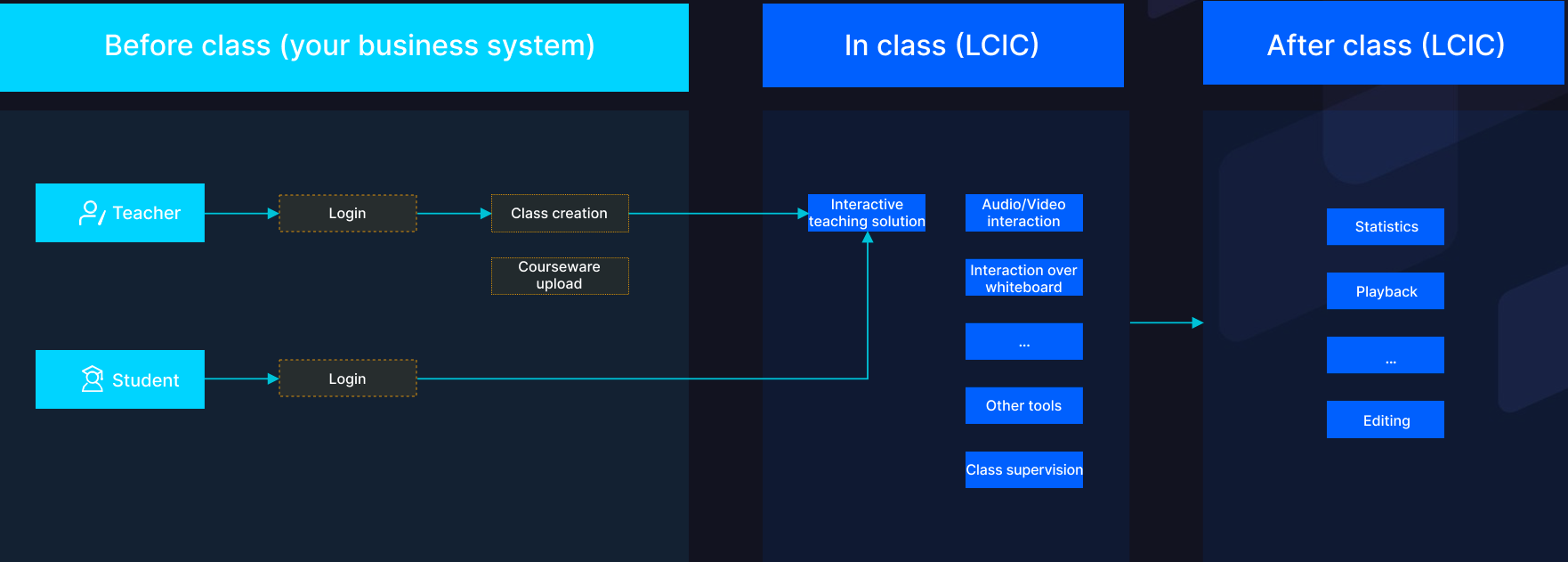产品概述
最后更新时间:2024-12-12 11:46:45
简介
实时互动-教育版是腾讯云整合音视频产品能力构建的 aPaaS 在线课堂解决方案。通过低实时互动-教育版提供的 SDK 产品服务,开发者无需深度学习音视频的复杂核心逻辑,即可将实时互动-教育版 SDK 无缝嵌入到自己的业务系统中,搭建自有品牌的在线互动课堂,极大地节省了开发时间,降低了开发门槛。
实时互动-教育版支持老师、助教、巡课、学生等多种课堂角色,具备实时音视频互动、实时消息互动、课件文档演示、互动白板、实时录制、屏幕共享、教学组件(如答题器、奖杯、计时器)等丰富功能,适合教育行业各教育类型,例如高等教育、职业教育、素质教育、 K12 教育等领域。教学场景上覆盖一对一/私教课、互动小班课、互动大班课、公开课、大班直播课、双师课、在线艺考/艺术培训、在线自习室等场景。
实时互动-教育版不会存储机构业务敏感数据,具有高灵活性、高安全性的特点,能够满足机构各种业务、场景诉求,机构只需按需选择各端口功能,即可组建自己的在线课堂服务。实时互动-教育版提供标准教室界面,通过 SDK 方式提供给机构,机构可以在自己的业务流程中按需唤起课堂界面开始上课。下课后机构通过 API 获取课中数据,完成教学闭环。实时互动-教育版支持自定义 UI 和自定义组件,支持业务功能的灵活拓展,可以与教学机构的业务系统(用户系统和排课系统)无缝对接。


实时互动-教育版提供 API 用于上述课中流程的对接。 API 提供排课、约课、用户管理,课堂登录验证等服务,涉及:课堂创建、课件上传、课堂登录验证、课中视频、课中相关数据获取、课后回放视频获取等,覆盖了整个课前、课中、课后的 API 使用场景。
aPaaS 和 PaaS 教育解决方案区别
实时音视频 TRTC 针对在线互动课堂提供 aPaaS 和 PaaS 两种解决方案。下表列出这两种解决方案的详细区别:
类别 | aPaaS 教育解决方案 | PaaS 教育解决方案 |
方案介绍 | 使用 TRTC 实时互动-教育版来实现在线互动教学场景。 | 分别集成实时音视频 TRTC 、互动白板、IM 即时通信、对象存储、CDN、点播服务来搭建在线互动教学场景。 |
适用客户 | 适用于开发资源有限、排期紧、需要快速上线在线互动教学场景、有定制化需求的客户。 | 适用于开发资源充足、对定制化需求较高的客户。 |
开发成本 | 低 | 高 |
上线时间 | 最短 15 分钟 | 1 个月至 3 个月 |
实现功能 | 提供课堂内的实时互动功能,支持实时音视频、实时消息、互动白板、实时录制、屏幕共享等核心功能。提供接口 API 用于课堂和用户管理。支持业务功能的灵活扩展,能够与教学机构的用户系统和排课系统无缝对接。 | 客户自行实现实时音视频、实时消息、互动白板等功能。 |
可拓展性 | 较强 | 强 |
业务数据安全 | 不保存客户的业务数据。 | 不保存客户的业务数据。 |
前端 UI | 提供默认的课堂 UI 且支持定制化修改。 | 客户自行实现所有 UI。 |
平台 | macOS Windows Web Android iOS 小程序 | 支持超过 20 个平台和框架。 |
支持场景 | 一对一课、互动小班课、互动大班课、公开课/大班直播课、双师课、在线艺考/艺术培训、在线自习室等多类授课场景 | 客户自行定义和实现任意在线互动教学场景。 |
课堂角色说明
实时互动-教育版支持以下角色:
课堂角色 | macOS | Windows | Web | iPad | Android Pad | iOS | Android | 小程序 | H5 |
老师 | ✔ | ✔ | ✔ | ✔ | ✔ | - | - | - | - |
学生 | ✔ | ✔ | ✔ | ✔ | ✔ | ✔ | ✔ | ✔ | - |
助教 | ✔ | ✔ | ✔ | ✔ | ✔ | - | - | - | - |
巡课 | ✔ | ✔ | ✔ | - | - | - | - | - | - |
文档反馈

